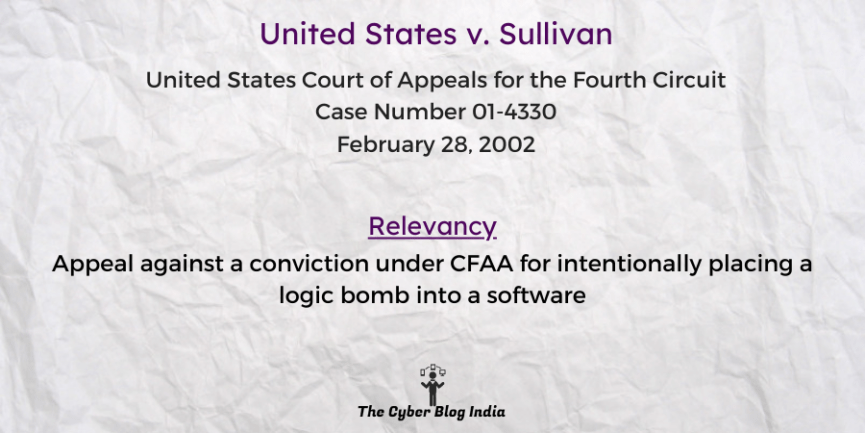United States v. Sullivan

United States v. John Michael Sullivan
In the United States Court of Appeals for the Fourth Circuit
Case Number 01-4330
Before Circuit Judge Niemeyer, Circuit Judge Luttig, and Circuit Judge King
Decided on February 28, 2002
Relevancy of the Case: Appeal against a conviction under CFAA for intentionally placing a logic bomb into a software
Statutes and Provisions Involved
- The Computer Fraud and Abuse Act, 18 U.S.C. § 1030
- The Federal Rules of Evidence, 1972 (Rule 404(b))
- The Federal Rules of Criminal Procedure, 1944 (Rule 29)
Relevant Facts of the Case
- Sullivan worked as a programmer. When he became upset with his employer, Lance, Inc., he implanted a computer code (logic bomb) into the software he was developing for Lance.
- The code was written to deactivate a communication feature in Lance’s handheld computers. Sullivan then resigned.
- Four months later, the device went off, shutting down 824 handheld computers that Lance’s sales representatives used to interact with the headquarters.
- The government planned to submit evidence confiscated from Sullivan’s house and home computer before his trial.
- That evidence includes three versions of a web page (named “Dr. Crime”) discovered on Sullivan’s home computer, each of which Sullivan created between his last day at Lance and his confession to building the bomb.
- Upon confrontation by the FBI, Sullivan confessed to placing the device. He has appealed the admission of evidence taken from his house and the denial of his motion for judgment of acquittal.
Prominent Argument by the Counsels
- The appellant’s counsel argued that the evidence produced did not fulfil the requirements of Rule 404(b) of the Federal Rules of Evidence. He further submitted that the evidence was thus irrelevant, unreliable, and overpowered by undue prejudice. It also constituted an inessential claim. The counsel argued that the trial court’s denial of his motion for judgment of acquittal was invalid as there was insufficient evidence to sustain his conviction. Moreover, the government has failed to prove that he knowingly caused the transmission of logic bombs to handheld computers.
Opinion of the Bench
- The appellant’s opening argument is unpersuasive. Sullivan’s “Dr. Crime’s Terminal of Doom” plaque and statements on the “Dr. Crime” web page were important in establishing an element of the crime.
- These statements were made when Sullivan could have informed Lance about the bomb and prevented their damage. Therefore, they are all the more probative of the critical element of his intent to cause damage.
- The appellant’s claim that neither the web page nor the plaque declares that he committed other computer crimes has nothing to do with the reliability of the admitted statements in showing his intent to commit this specific offence. Hence, the evidence is reliable.
- In any case, the restricting instructions prevented any potential unfair prejudice. Hence, the district court did not abuse its discretion.
- The appellant’s denial of the motion argument was invalid because the appellant had confessed to the offence and how he planted the logic bomb.
- Concerning the damage over one year, the bench ruled that the uncontested testimony offered by an employee who replaced Sullivan after he quit claimed that the memory card was purchased a few days after the bomb went off. As a result, the bench concluded that the district court did not misuse its discretion in refusing Sullivan’s Rule 29 request.
Final Decision
- The bench rejected the appeal and affirmed Sullivan’s conviction and sentence.
